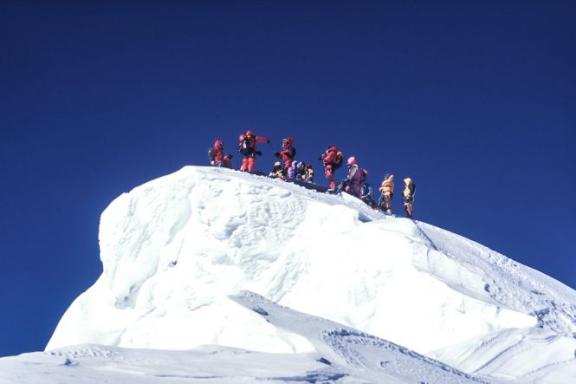Conceived by Dick Bass and Franck Wells in 1985, the Seven Summits challenge involves climbing the highest peak on each of the seven continents: Everest (8,848 m) in the Himalayas for Asia, Aconcagua (6,962 m) in Argentina for South America, Mount Denali (6,190 m), ex-Mac Kinley in Alaska for North America, Kilimanjaro (5,895 m) in Tanzania for Africa, Elbrus (5,646 m) in Russia for Europe, Mount Vinson (4,892 m) in Antarctica and the Carstensz Pyramid (4,884 m) or Puncak Jaya in Indonesian Papua for Oceania. Add the North and South Poles, and the challenge is called the Explorer's Grand Slam. We'll help you complete it. In this article, we take a look at each of these expeditions, three of which are now virtually inaccessible.
See all the climbs of the Seven Summits challenge.
Seven Summits challenge with Expeditions Unlimited
We offer a complete list of the Seven Summits Challenge. We've climbed them all... thanks to you! For the 7 Summits, we've opted for Messner's list, which favors the Carstensz Pyramid in Oceania. Elbrus in Europe is sometimes disputed from an orographic point of view, and Mont Blanc is sometimes given as the highest summit in Europe.
Perhaps in the light of current events, we need to rethink our approach! It has become complicated, if not impossible, to climb Elbrus in Russia. And trekking to the base camp of the Carstensz pyramid has become impossible, if not quite impossible, as its ascent has been banned since 2019, due to regional political and social instability.
Perhaps the opportunity to relaunch the Kosciusko in Australia, which is part of Dick Bass's list of Seven... Whatever the variant, there were just over 400 who had declared themselves as having achieved it by the end of 2016 according to www.7summits.com, including around ten Frenchmen. Today, there are perhaps 500 or 600, hardly more.
Explorer's Grand Slam with Expeditions Unlimited
And we were privileged to accompany our friend Jérôme Brisebourg on his polar leg, the second Frenchman after explorer François Bernard to complete the Explorer's Grand Slam when he reached the South Pole on January 13, 2020 via the Axel Heiberg glacier. This particularly challenging route is the one Roald Amundsen took to reach the planet's southernmost point on December 14, 1911.
Around 50 people worldwide have completed the Explorer's Grand Slam, 13 of them reaching the North and South Poles from the coast, and a further 10 including at least one pole from the coast, the other being made on a last degree.
The Covid, followed by the closure of Russia and the consequent impossibility of setting up the base at Bareo, prevented any access to the North Pole, either on the last degree or from the pack ice. The last year the North Pole was possible was 2018, and we were there with Dixie, Jérôme and Michel!
The 7 summits of the Seven Summits Challenge
The 9 expeditions of the Explorer's Grand Slam
We propose to tackle the Seven Summits in ascending order of difficulty, finishing with the North and South Poles for the Explorer's Grand Slam.
- Kilimanjaro (5,895 m) in Tanzania, Africa's highest peak
- Elbrus (5,646 m) in Russia, highest peak in Europe
- Puncak Jaya or Carstensz Pyramid (4,884 m) in Indonesian Papua, highest peak in Oceania
- Aconcagua (6,962 m) in Argentina, South America's highest peak
- Mount Vinson (4,892 m) in Antarctica, the highest peak... in Antarctica!
- Mount Denali (6,190 m) in Alaska, highest peak in North America
- Everest (8,848 m) in the Himalayas (Nepal/Tibet), highest peak in Asia
- North Pole last degree or from Russia (or Canada)
- South Pole last degree or from Ross or Hercules Inlet Barriers
Expeditions Unlimited can assist you with all those expeditions.
Ascension du Kilimandjaro à 5 895 mètres, toit de l'Afrique
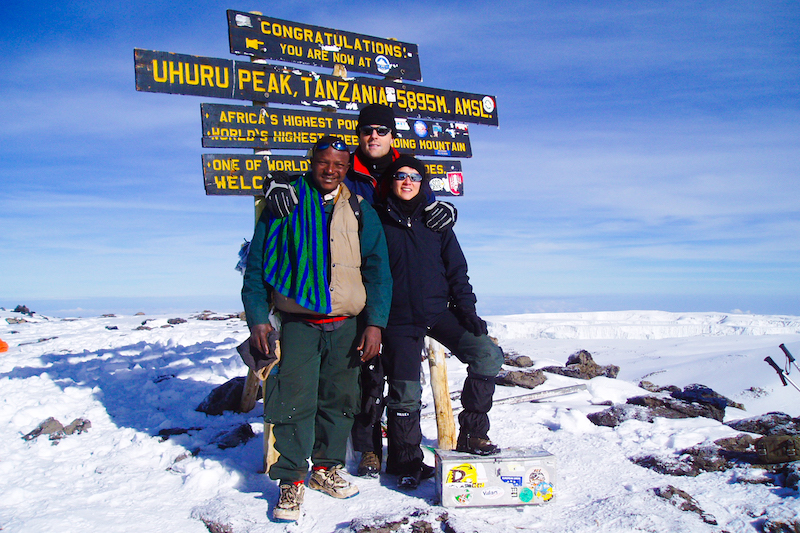
Kilimandjaro summit © Jérôme Brisebourg
This climb is not technically difficult, but requires a good acclimatization to be successful and carried out in good safety conditions. We recommend a seven-day ascent, preferring the beautiful Machame route. If we're in good shape at the summit, we'll stay up there for a while to contemplate the dwindling summit glaciers of the roof of Africa. Your expedition includes individual rooms and tents for better rest. Communication and medical equipment included. Other routes are also possible (Marangu, Rongaï, Shira, etc.), or even acclimatization on Mount Kenya, Africa's second highest peak at 5,199 meters. And why not a Rwenzori/Kenya/Kilimanjaro African summit trilogy?
Numerous departures with English-speaking guides all year round, except from March to May.
Ascension de l'Elbrouz à 5 642 mètres, toit de l'Europe
.jpg)
Elbrouz summit © Pascal Denoel
We attempt the summit (5,642 m) via the more beautiful and wilder north face, without the lifts of the south face... After adequate acclimatization, we tackle the difficult and lengthy summit assault in good conditions. It will take us almost twelve hours to reach the summit, from the advanced base camp at 3,760 meters, with 1,800 meters of ascent and 1,800 meters of descent. Excellent physical condition and good stamina are required to attempt this ascent. Fickle weather is a decisive factor in the success of the climb, as is global geopolitics.
Given the Russian-Ukrainian war, our departures are currently frozen for our European customers.
Ascension du Puncak Jaya à 4 884 mètres, toit de l'Océanie
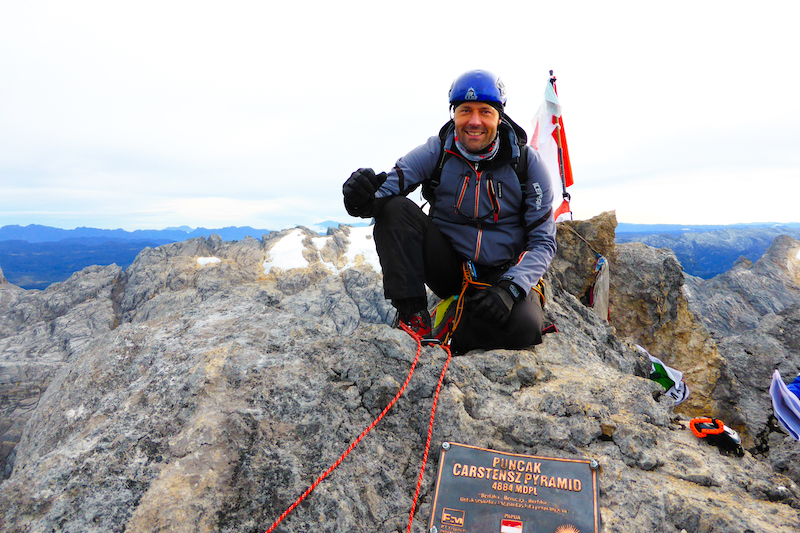
Carstenz summit © Jérôme Brisebourg
We're off on one of the world's most exotic high-altitude expeditions, in Indonesian Papua, to climb the Carstensz pyramid or Puncak Jaya at an altitude of 4,884 meters, a mysterious and little-visited objective, flanked by glaciers, a great limestone escarpment rising out of the rainforest. This expedition combines adventure and climbing. We climb the north face of the mountain over the course of a long day, from base to summit and back. The guides install fixed ropes at the most difficult sections to allow faster access to the summit ridge and a quick descent afterwards. Trekking with the Papuans remains one of the highlights of this adventure.
Due to strong and particularly violent local instability, our departures are currently not possible.
Ascension de l'Aconcagua 6 962 mètres, toit de l'Amérique du Sud
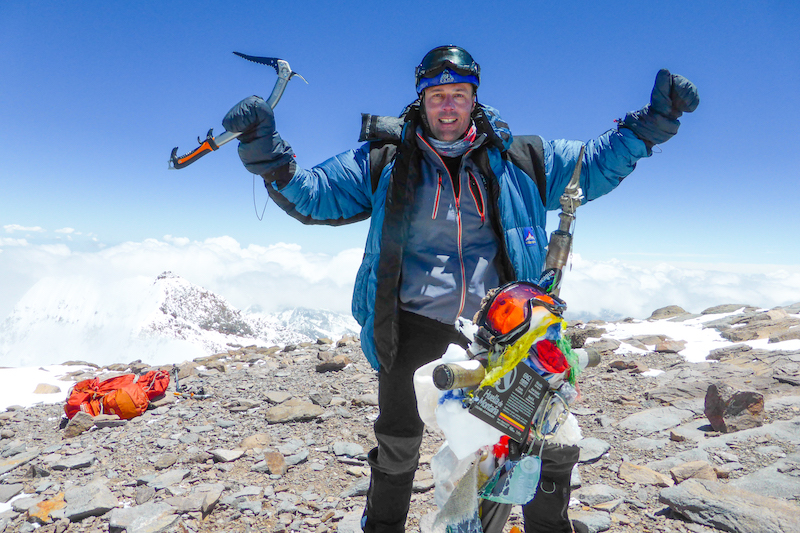
Aconcagua summit © Jérôme Brisebourg
This mythical 7,000-meter peak, the highest in South America, presents no particular technical difficulties on the normal route. The fact that it is one of the 7 Summits is what makes it such a success, attracting climbers from all over the world. Due to its location at the tip of the southern hemisphere, where the climate is particularly dry, the route is snow-free most of the time. The northwest ridge is the normal route to the summit. The main difficulty lies in the very high altitude and the often violent winds that sweep across the summit. We also offer a ascension de l'Aconcagua en traversée.
There are several departures between November and February, some of them with a French-speaking guide.
Ascension du mont Vinson à 4 892 mètres, toit de l'Antarctique
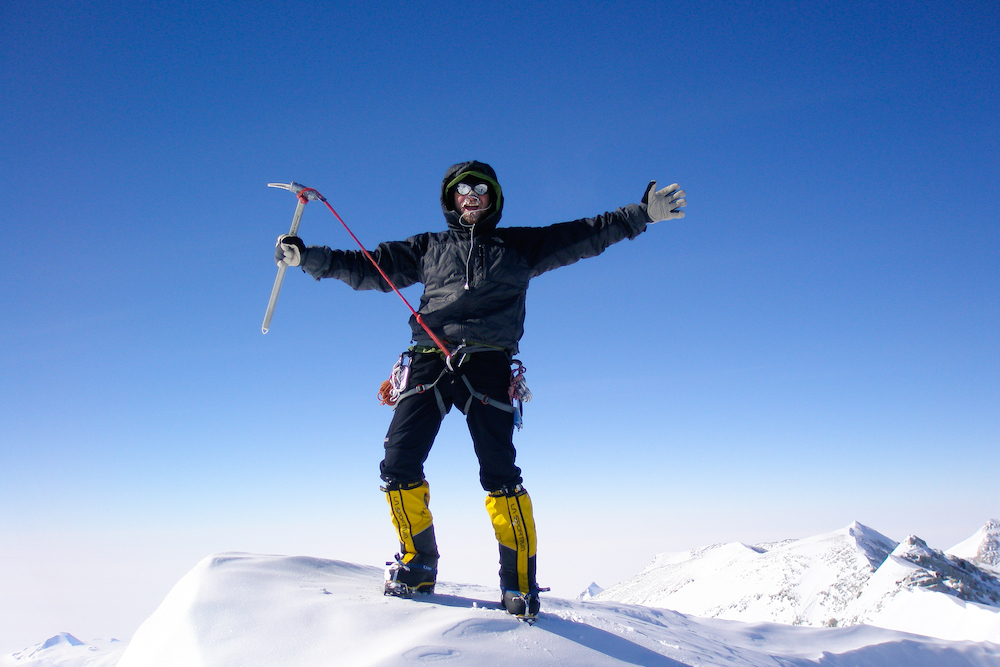
Vinson summit © Chris Nance
You climb the Branscomb Shoulder Route, with its beautiful glaciers and 40° slopes, exposed high plateau and spectacular summit ridge. Majestic snow-capped peaks protect vast glaciers below, and in the distance, snow hugs the sky along a sharply curved horizon... To climb Mount Vinson is to challenge yourself on a mountain unlike any other, in one of the most remote regions on the planet. Its very southerly position makes it a more difficult summit than if it were on the equator at the same altitude. And the cold is one of the main risks of the climb, especially when arriving on the exposed ridge. In view of the expedition's substantial budget, you might want to consider combining it with the South Pole to save a few bucks, if you're aiming for the Explorer's Grand Slam.
Several departures every year between early December and mid-January.
Ascension du mont Denali à 6190 mètres, toit de l'Amérique du Nord

Denali summit © Eric Bonnem
Denali, North America's highest mountain, has few equals in terms of technical challenge and scenic beauty. Located 210 kilometers north of Anchorage, Alaska, it rises above a sea of glaciers and other peaks that make up the Alaska Range. Thanks to our preparation and the make-up of our group, we offer experienced mountaineers a solid chance of achieving their goals. We take the classic West Buttress Route. We start at base camp in Denali National Park and Preserve, where we're dropped off by private plane, then set off on pulka skis or snowshoes with around 80 kilos to pull up to advanced base camp at around 4,300 metres. From there, the summit is reached in alpine mode. A completely self-sufficient adventure with one big challenge: the Pacific weather.
Departure every year around mid-May.
Climbing Everest to 8,848 meters, the grail
The world's highest mountain can be climbed from either the Nepalese or Tibetan (Chinese) side. The Nepalese side is technically more demanding and physically tougher in its first part, with the Icefall in particular. But the final ridge at over 8,000 meters is longer on the Tibetan side. The weather on the Tibetan side is said to be a little more favorable, as the Himalayan barrier blocks the disturbances and then the monsoon that generally come from the south.
Nepal is less selective, and almost 500 permits have now been granted to non-Sherpa mountaineers, compared with less than 200 on the Chinese side. The Chinese are even expected to request their first 8000m as a condition for climbing Everest from their side.
Nepal quickly reopened its doors in 2021, whereas China remained closed from the beginning of 2020 to the present day, i.e. almost 4 years.
Prices are similar between the two slopes, as are departure dates: spring remains the preferred period.
Ascension de l'Everest à 8 848 mètres par le versant sud népalais
.jpeg)
Everest summit @ Yorick Vion
The route follows the route successfully climbed in May 1953 by Sir Edmund Hillary and Sherpa Tenzing Norgay, and is now climbed in four successive camps. The main technical difficulty lies in crossing the Khumbu Icefall. To reach the South Col, you have to climb slopes of between 30 and 45°. Beyond the South Col, the technical difficulties remain low, but the violent winds, the high altitude and the weight of the rucksack with oxygen cylinders constitute the great difficulty. A mythical, demanding expedition, requiring experience of high altitude.
Ascension de l'Everest par la voie tibétaine
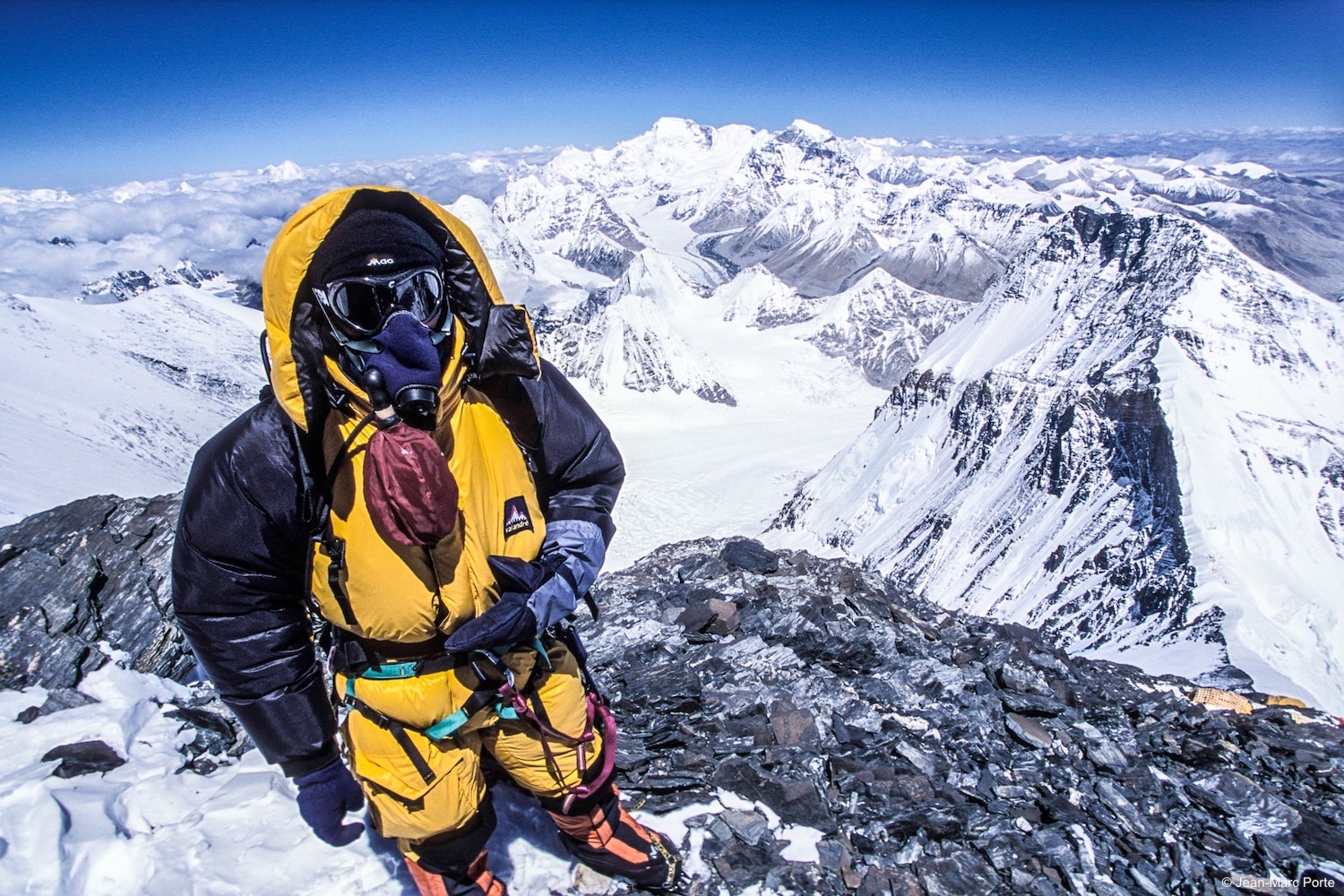
Everest summit © Jean-Marc Porte
We're off on the ultimate expedition, the one many dream of doing: climbing the roof of the world via the Tibetan side, a mythical route on which the British launched no less than seven unsuccessful expeditions between 1921 and 1938. The scene of Mallory and Irvine's exploits and demise. The very long ascent of the Rongbuk East Glacier brings us to the foot of the first difficulty: the ascent of the glacial slopes leading to the North Col (7,000 m). Then comes the long climb up the north face to reach the north-east ridge at around 8,000m. We still have to climb the first and second ressauts, the most difficult sections of the entire ascent.
The route, technically easy, is subject to violent winds, including the dreaded jet stream, an altitude current capable of putting an end to the best climbers' progress. A major advantage over the “classic” south-facing route in Nepal: here, there is no Icefall to cross, but a very long, demanding route from start to finish. For many, the dream and achievement of a lifetime.
Departures in early April on both slopes.
Expédition au pôle Nord géographique en ski pulka
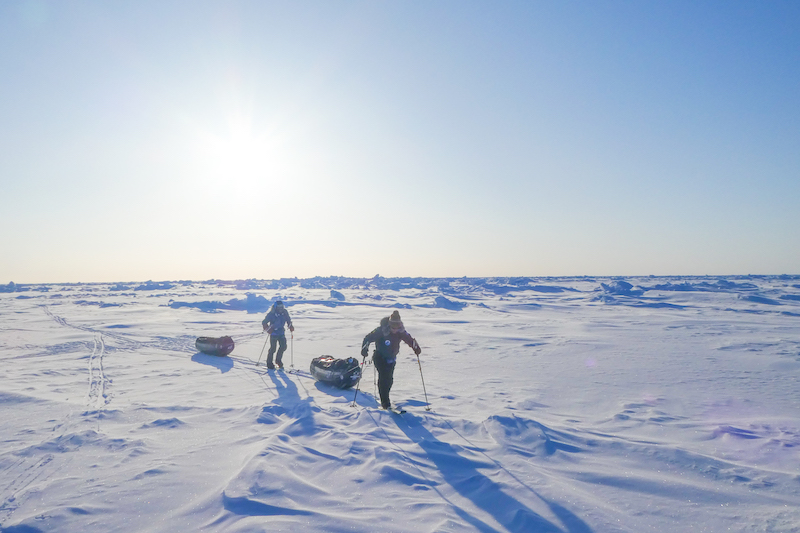
Atteinte du pôle Nord © Jérôme Brisebourg
We fly to the Russian base of Barneo, then reach the starting point of our expedition at latitude 89° North. This rare expedition will enable us to reach this mythical point in perpetual motion. Accompanied by a particularly experienced polar guide, we'll need determination to get there, pulling our heavy sledges between compression ridges and battling against the transpolar current. One last degree, 111 kilometers and ten days later, to reach the North Pole.
For the more motivated, we propose a round trip from Barneo to the North Pole, or two degrees to reach the Pole, i.e. 220 kilometers. A departure from Cape Artechevsky is also conceivable, a 2-month expedition for a challenge that no one has succeeded in over the last 15 years.
Given the Russian-Ukrainian war, our departures are currently frozen for our European customers.
Expédition au pôle Sud en ski pulka
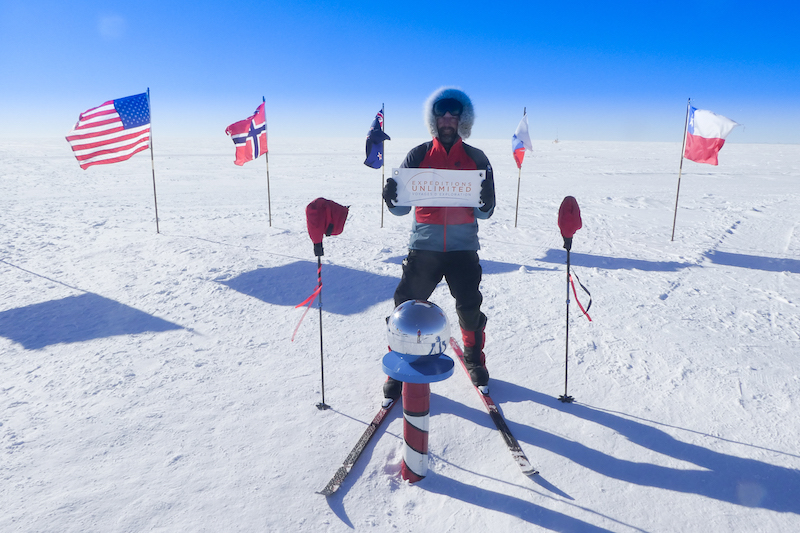
South Pole © Jérôme Brisebourg
Few people have reached the South Pole on skis. This short expedition enables us to reach this mythical point. From Punta Arenas, we fly to Union Glacier. After a couple of refuelings, we reach the starting point of our expedition at latitude 89° South by Twin Otter. Led by an experienced polar guide, we pull our sleds through sometimes extreme weather conditions. One last degree, 111 kilometers and ten days later, we reach the South Pole and the American Amundsen-Scott station.
A mythical and pure expedition in every sense of the word. A longer version from Messner start, Hercules Inlet or via the Axel Heiberg glacier is also possible for the more experienced. Allow one to two months for the expedition.
Several departures every year between early December and mid-January.
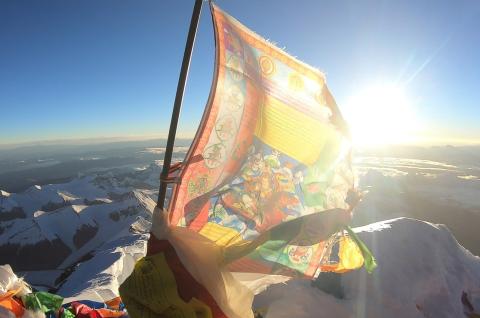
Climb mount Everest at 8849 meters South Nepal side
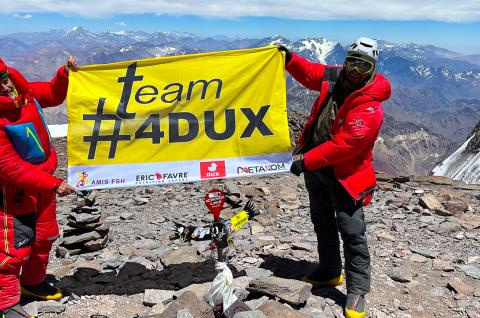
Climb Aconcagua at 6962 meters standard route in Argentina
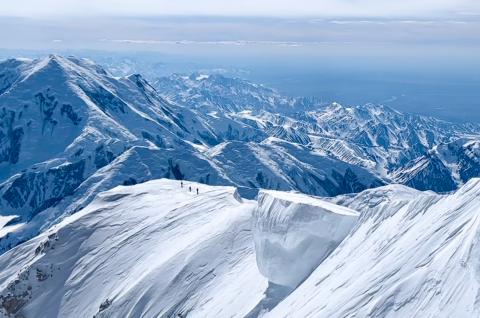

 Expeditions Unlimited blog
Expeditions Unlimited blog